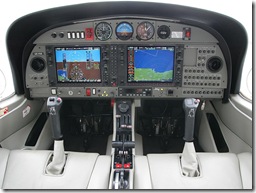
The Diamond DA-42 is the first completely new piston twin to fly in nearly thirty years and it is, quite simply, a revolutionary aircraft. It is the first to combine the latest avionics and composite construction with modern engines. When the first production model is delivered later this year, it will be an aircraft that challenges rivals costing more than twice as much.
But if the engines, performance and price are likely to make owners happy, the avionics will make them giggle like children at Christmas. The Garmin G1000 system replaces all the usual dials and gauges with two large flat panel displays, transforming the cockpit from a WW-II bomber into the Starship Enterprise. One screen displays airliner-style flight instruments and engine gauges and the other shows a moving map, which integrates traffic, weather and terrain. The two can be swapped to allow the right hand passenger to fly and there are backup instruments on the coaming. Combined with a GPS-coupled autopilot this kit will make instrument flying safer and easier.
I flew pre-production test aircraft at the company’s Austrian factory. Starting up is a push-button affair. The fully automatic digital engine control, a feature usually found on business jets, makes power checks just as easy. The cockpit layout is very straightforward because the two G1000 screens contain nearly all the information you need to fly. The overall result is a clean and efficient dashboard. The throttle quadrant is just as neat with one lever per engine controlling mixture, pitch and throttle.
Take-off acceleration is brisk followed by a rapid climb above the clouds and the Austrian Alps at around 1,700 feet per minute. A simulated engine failure is a non-event. It climbs comfortably on one engine at 700 feet per minute fully loaded and only a light touch of rudder is needed to keep it flying straight.
The stick is mounted on the floor between the knees as God intended and it contributes to a fighter-like responsiveness. A series of maneuvers, including very steep turns and slow flight revealed an aircraft that remains taut, stable and well-harmonized throughout its flight envelope. Comfortingly, unlike some modern designs, the DA-42 has completed a full spin matrix as part of its certification. Returning to Wiener Neustadt airport, we flew a straightforward VFR approach. A 70 knot slow approach is possible while the high maneuvering speed limit allows fast approaches, which will make it easier to mix with the big boys at large, controlled airports.
Among aircraft in production today, the twin-engine Beechcraft Baron 58 and the Piper Seneca V are closest to the DA-42 in configuration. They are serious
Ironically, Diamond’s biggest competition is probably not the other light twins but the single-engine Cirrus SR-22. Along with similar performance and price, the DA-42 shares the Cirrus’s composite construction and clean lines. However, the Diamond will be more economical to run. While the single-engine Cirrus has an emergency parachute, Diamond engineers reckon that most pilots will feel safer with a spare engine.
The aircraft is expected to cost around $360,000. Because the glass cockpit is standard, there are only likely to be three options: a luxury interior package with leather seats and trimmings, an oxygen system and a TKS de-icing system. The aircraft is due for certification around April and first deliveries should take place in the summer. Thanks to a substantial order backlog, if you order one today you may have to wait until 2006 to take delivery (although US dealers may have inventory sooner).
If production models live up to the promise of the prototype, the DA-42 could signal a renaissance for the light twin market. It promises to be a pilot-friendly, safe, efficient luxury tourer. More importantly, it will be a lot of fun to fly.